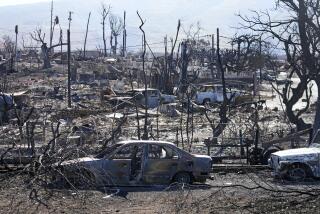Winter Brings Bleak Options for Poor
- Share via
BOSTON — Winter has barely begun, and the soaring cost of home heating oil has already forced the poor to cut back on food, medicine and clothing -- a plight known in the frigid Northeast as “heat or eat.”
Heating oil costs doubled in the last two years and climbed 21% during November and December, the Department of Energy said.
Consumers all over the country are feeling the pinch. But the effect has been most dramatic in New England, where 80% of the nation’s heating oil is used and where policymakers are tracking a phenomenon called energy poverty.
When 3 feet of snow fell on the northernmost part of Maine after Christmas, state officials got scores of calls for help.
One man had 35 gallons of heating oil in his tank -- less than a week’s worth even if he kept his house below 60 degrees -- and not enough money to buy more. In his 50s and on disability, he said he wore two pairs of socks, two sweatshirts and a jacket inside his house, which was 50 degrees.
A mother said she and her two kids were sitting in front of the clothes dryer to stay warm.
Murdock Cote, 43, called from Ashland, near the Canadian border, to say he had used his last $100 to buy oil for his nearly empty tank. But he couldn’t get it delivered because his long, steep driveway was buried in snow -- and Cote, who is disabled, couldn’t afford a plow service.
“It’s been minus 5 degrees at night,” he said. “And this is only the first snow. It’s going to get a whole lot worse.”
States like Maine say they are hamstrung because federal money to help the poor pay their energy bills has not increased substantially in the last two years, despite the jump in fuel costs. Approximately $2 billion in federal aid helps fund heating and air conditioning for about 5 million low-income households across the country.
Most of the heating funds already have been distributed to the poor, said Beth Nagusky, director of Maine’s energy policy. She said the hardship stories broke her heart.
“Keeping people warm is a top priority,” she said. “And it is increasingly difficult without Washington’s help.”
Local officials who rely on federal dollars to manage low-income heating programs “wait truly with bated breath every year to find out what that figure will be,” said Michael Ferrante, president of an industry advocacy organization called the Massachusetts Oil Heat Council. The flat-line federal appropriation is in effect a dramatic cut because of rising fuel costs.
“It isn’t enough money,” Nagusky said. “The state is struggling to provide more, but it will mean cutting other programs, and Maine already has made significant cuts in programs across the board.”
Nagusky said Maine to date had received $24.2 million in funds from the federal Low-Income Home Energy Assistance Program. Of that, $19.4 million will buy heating fuel for 48,000 households -- about 180 gallons per household, less than one full tank. Most heating oil users who keep their homes about 65 degrees go through three or four 275-gallon tanks per winter.
Across New England, states are scurrying to pass stopgap funding plans, even setting up government-sponsored charities to help people heat their homes. Friday, the White House released an additional $100 million for low-income heating aid.
Former Democratic Rep. Joseph P. Kennedy II has anxiously monitored the situation. As chairman of Citizens Energy Corp., which supplies heating oil to low-income customers in Massachusetts, Kennedy said the rapid escalation of heating costs could bring dire consequences.
“I believe there will be hundreds of people who will suffer and die this winter,” he said.
In November, Massachusetts made a deal to buy heating oil from Venezuela. The agreement brokered by Democratic Rep. Bill Delahunt sends 12 million gallons of heavily discounted heating oil to the state over the course of four months this winter.
Officials in Maine and Rhode Island also are negotiating to buy fuel from the Venezuelan government and expect to announce deals shortly.
Republican Gov. Donald L. Carcieri was so concerned about how 20,000 indigent households in Rhode Island would get heat that he asked the Legislature to convene a special session to consider funding proposals. Legislators said no, so Carcieri wrote to the White House -- with no success.
But legislators in Massachusetts were quick to act this fall, passing a $20-million authorization for emergency heating funds for low-income households -- triple the allotment of last winter and by far the largest in state history. The state allocation will supplement federal funds.
Democratic Gov. John E. Baldacci of Maine was out with a hammer and nails this fall, part of a crew that installed insulation for 2,800 low-income households. Baldacci also launched a “Keep Maine Warm” charitable fund. Last week, he signed a bill that makes $5 million available to help pay for heating costs.
The measure, which marks the first time the state has supplemented federal heating funds, gives the average low-income household in Maine about $546 in heating aid this winter, enough to buy about 233 gallons of fuel -- about 40 gallons short of a typical full tank.
The average annual household income of those served by federal fuel assistance in Maine is $12,000. Most families who keep their homes at 65 degrees or below use 5 to 10 gallons per day.
David L. O’Connor, commissioner of the division of energy resources in Massachusetts, said heating oil costs had shot up because demand had outpaced supply. Developing countries, especially China and India, have steadily upped their energy requirements, O’Connor said. “And because energy is a world market, that matters to us in New England.”
Hurricanes Katrina and Rita had a small influence on this season’s leap in heating oil costs, he said. But with no new refineries under construction in the United States, he said the real problem -- “the underlying driver of all of this” -- is lack of supply.
Consumers who heat with natural gas or electricity have a built-in safety net because most states forbid those utilities from being shut off. When a home heating oil tank runs dry, there is no alternative.
“Already, many families have run through their heating oil supply for the winter,” said Ann Dufresne, press secretary to state Senate President Robert Travaglini. “In Massachusetts, the rest of the winter is yet to come.”
Oil prices dropped slightly last week, but John E. Parsons, executive director of the Center for Energy and Environmental Policy Research at MIT, said there was no way to know whether that trend would continue. Indeed, he said, “there is a lot of volatility and a danger that [prices] could go up.”
The repercussions extend beyond depleted bank accounts. When families with children under 3 scrimp on food to pay for heat, said Dr. Deborah Frank, director of the Failure to Thrive clinic at Boston University medical school, “We know that it is correlated with ill health, increased hospitalization and impaired learning.”
In Quincy, south of Boston, Linda and Paul Kelly were selected by officials and Citizens Energy to be the first homeowners to receive Venezuelan oil. Linda Kelly, 44, said she read up about Venezuelan President Hugo Chavez to make sure he “wasn’t some Mussolini-type guy.”
The Kellys were desperate for relief from high heating bills, and the Venezuelan oil was supplied at a 40% discount. When they first began receiving heating oil assistance five years ago, the Kellys paid 80 cents a gallon. Last year, the cost was $1.59 per gallon, and this winter, $2.59.
“Who can budget when it goes up like that?” Linda Kelly said.
She has multiple sclerosis and one of her three children is diabetic. When her husband is working at his job in the food industry, she keeps their small three-bedroom house cool -- never above 65 degrees. At night, she lowers the thermostat by 10 degrees. Still, in just over a month, the family has gone through half a tank of heating oil.
She said she was worried. “This is about a crisis of basic needs,” she said. “Someone needs to take a look.”
More to Read
Sign up for Essential California
The most important California stories and recommendations in your inbox every morning.
You may occasionally receive promotional content from the Los Angeles Times.










